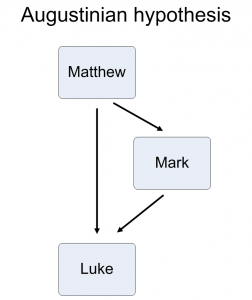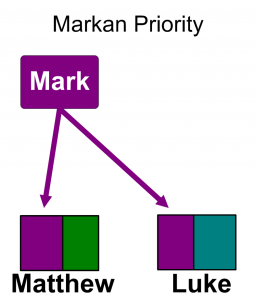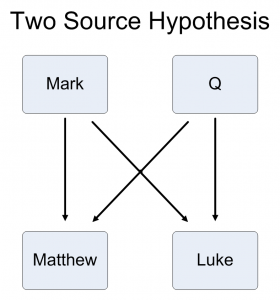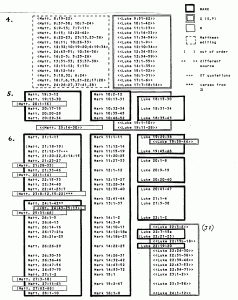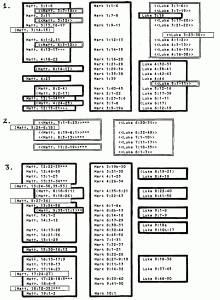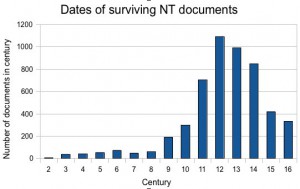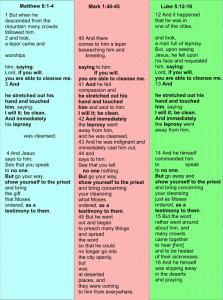Data Analysis and Hypothetical Reality: The Q Document as a Citable Source
The Synoptic problem in Biblical studies has generated much speculation and intense debate and remains one of the pivotal areas of contention within the field. Much of the debate has centered on source criticism and the hermeneutic polemics involved in the attempt to explain and understand the relational complexity of the three synoptic Gospels. In lieu of the scholarly determination regarding the chronological sequence of the composition of the Gospels (Mark, Matthew, Luke – though there are continued disputations regarding exact dates and sequence that would require much more space to engage), the Markan Priority proposition replaced the Augustinian model that argued for Matthew as the first composition and that Mark and Luke derived their source material from there.
Major issues with the Markan model ensured that further scholarly excavations were necessary. Shared material in Matthew and Luke that is not evident in Mark invited a more rigorous analysis of the complex relational materials in all three Gospels. A two- source hypothesis was developed in the nineteenth Century based upon a new more secularized and scientifically grounded scholarly approach. Quantitative analysis allowed for the building of graphic models and charts that cross referenced the Gospels through the individual words and phrases that were common to at least two of the texts and demarcated those gaps or “empty spaces” that separated the structural and compositional characteristics of the three narratives. This visualizing procedure enabled scholars to refine their analysis and introduce the post-enlightenment emphasis on “reason” to a field of research hitherto relegated to the realm of transcendental divinity. The resulting graphic postulations evolved into what has been designated as the Quelle (Q) source – a reconstructed document – a sayings collection that works as a corollary to the Two Document Hypothesis (2DH).
This simplified graph derived from the complicated charts that were painstakingly pieced together through the process of close reading.
This was, of course, before the digital age and close reading was the only option. It does, however, suggest that the scientific approach to textual analysis and thematic determinations was employed in relation to acceptable texts deemed to be of great importance. The hierarchical position of the bible in the nineteenth Century ensured its prominence within the social networks that enabled the proliferation of new discursive formulations that contributed to the emergence of a more secularized modernist sensibility. The advent of scientific methodology was recognized as a constructive tool in the approach to and analysis of a transcendental socio-political institutionalized cosmological foundational text that touched and influenced most aspects of Western civilization’s development through discursive networks that embraced most elements of the social. Scientific developments in the cultural transformation of the post enlightenment era remodeled perceptions and perspectives even within the realm of the sacred: “The ‘Synoptic Problem’ or the question of the literary relationships among the Gospels is rather like the nuclear physics of biblical criticism, full of mathematics, charts, and algebraic unknowns. Yet like physics, it remains a fundamental building block of other types of Synoptic analysis” (Kloppenborg 12).
A new discursive entity was formulated based on a hypothetical conclusion grounded on a data driven methodology that was achievable due to the limited contents of a theologically constructed canon of redacted and compromised texts. What is ingenious to this hypothetical document is its developmental status within the academic discourse of biblical studies. Unlike the canonical texts of the bible, there is no empirical evidence of the Q document’s existence. There is no archeological affirmation or patristic reference to such a text. It is a purely hypothetical construction seemingly lacking in any concrete materiality. Yet, in the discursive realm of biblical scholarship it contains substance and body. It is referenced and cited and scholars have reconstructed a text, proclaiming it to be the actual Q source:http://www.earlychristianwritings.com/text/q-funk.html. In other words, through a scientific based data retrieval methodology, an ancient (new) sacred text has been introduced to the academic community and has been given an actual tangible materiality. Once this materiality and status is bestowed upon the data based hypothesis, the quantitative research that commenced the project is transformed – it is no longer “data which is ideally independent of interpretations” (Moretti 72) – it is now subject to the same scrutiny and transcendent hermeneutic rigor that is applied to the other texts designated as “sacred”. As such, it is no longer relegated to the discursive networks surrounding the objects of inquiry, it becomes an object in itself and cannot escape interpretative analysis as it is subsumed into the materiality of the actual texts (Gospels): “Q came to be regarded, not merely as an interesting idea for solving the Synoptic Problem, but a significant documentary source for the transmission of the Jesus tradition”(Kloppenborg 5, italics in text).
The reliance on a close reading in order to accumulate the necessary data was a manageable task because of the dismissal and suppression of alternative readings and texts related to the Jesus movement. The political enactment of a power based purging of competing ideologies related to the Jesus moment silenced a wide range of discursive networks that freely flowed during the first two to three centuries of the common era. The proto-orthodox attempts to eradicate alternative interpretations and narratives not only led to the classification of the so-called gnostic texts as heretical, but also led to the destruction of most manifestations of those alternative views. Their existence was only known through the writings of such early church fathers as Irenaeus and his second Century five-volume text entitled “Against Heresies”. The discovery in Egypt in 1945 of the Nag Hammadi Scriptures – fifty-two mainly Gnostic tractates – confirmed the existence of these alternative “Christianities” and incited a new discursive rupture within the academy. While the transformational impact of these discoveries and the radical transmutation of the discursive networks that mold the interiority of Religion and Theology Departments is vital in terms of the foundational stability of scholarly methodological procedures (the need to reassess much of the research in light of the new discoveries has opened up a number of new avenues – networks? – for scholarship in these disciplines), the introduction of new authentic early Christian texts to the discourse surrounding and shaping the networks that define the “space” of biblical investigation will encourage a more intensified statistical analysis.
Moretti suggests that his methodology does not necessitate the establishment of a solution to the problems that may arise: “I had found a problem for which I had absolutely no solution. And problems without a solution are exactly what we need in a field like ours, where we are used to asking only those questions for which we already have an answer” (Moretti 86 italics in text).This seems to be appropriately relevant in relation to biblical studies where transcendental hermeneutic inquiry is often insistent in confirming or disproving a dogmatic established conclusion. Until the nineteenth Century there was a conformity within the field that rarely excluded the belief in an existent divine authority that somehow lurked within the canonical texts even if the allegorical and metaphoric qualities were recognized and rational exegesis dismissed those aspects of the texts that were outside of rational acceptance. Rudolph Bultmann’s demythological approach acknowledged mythological exhortations of the biblical stories as impossibilities and proposed a re-mythological rendering of the bible so as to make it more palatable to the rational mind. But, he was still determined to establish the “truth” of divine revelation that he believed lurked beneath the hyperbolic narrative. The problems that the texts posed needed new and modern solutions. The answer was embedded somewhere within the discourse and networks and the analysis only needed to find a “new” means by which to extrapolate those hermeneutic certainties.The revelation of new contemporaneous texts has already invoked a remodeling of the fluctuating possibilities involved in new modes of theoretical critical approaches to biblical scholarship. The statistical possibilities of the digital advantages in terms of compiling data has already yielded or established new networks that are scraping the borders of the multiplicity of “spaces” that circulate within the academic spheres and are invading those spaces. The Gospel of Thomas has added a strong argument to the validity of the Q source as the sayings genre now has an evidential model for comparison. New charts and graphs have correlated these newly discovered sayings to those of Matthew and Luke and, in turn, to the constructed Q document. Other documents from Nag Hammadi have allowed scholars of Gnosticism to seek out further threads of discourse that relate to the heretical designations of the second Century exposing the political machinations of the proto Orthodox hierarchy. Oblique condemnations are now matched to the actual texts and clarify distinct disagreements and striking similarities between those texts that were canonized and those that were purged. Much of this analysis is greatly facilitated by the technological tools now available as well as the theoretical approaches that evolved from those tools. Piper’s argument that “When we read topologically we are reading our way through language’s historical entanglements” (Piper 378) seems apt in this context. Topology speaks of “a relation … as a conjunction of likeness and difference … the study of ration, neither the attempt to subsume difference nor to assert it absolutely … a form of reticulation, a study of the differences that reside within likeness and the likenesses that span difference (Piper 379-380). The historical critical method of Redaction criticism can now perform a style of topological distant reading in so far as the multitude of variants of any single Christian text or phrase within the text can be excavated through technological means and that same phrase or word can then be correlated (in terms of likeness and difference) to any of the other texts that are within the parameters of early Christian writings.
As the value of the non-canonical texts is recognized the need to utilize digital tools becomes obviously more relevant. The exclusivity of the biblical canon maintained a manageable corpus of textual materials. The borders that protected that exclusivity are being manipulated and the entire field of biblical scholarship is becoming susceptible to new theoretical propositions to accompany the growing number of non-canonical texts that have proclaimed (or are being proclaimed) their relevancy. In this way, biblical scholarship participates in the growth of technological assistance in scholarly inquiry. Established modes of thinking are being challenged and Christological, soteriological and eschatological paradigms are being reformulated as a result of changing discourses and evolving networks that are circulating and transforming the “sacred” landscape. But the old discursive forces that have circulated around the bible for the last two thousand years have an entrenched transcendental flavor that permeates western society well beyond the confines of biblical academia and these circulating agencies have contingency values that are predicated on hermeneutic absolutism that involve solutions that have been used to justify all manner of human behavior. That insistence on an interpretative objective remains firmly rooted in Theological studies and while the theoretical postulations that focus on the communicative pathways of flowing discourses are acknowledged and explored, the formulation, embrace and incorporation within the materiality of an established corpus of actualized physical “sacred” texts of a theoretical fabrication with no empirical or corporeal existence suggests a continued resistance that demonstrates little evidence of abating.
Works Cited
Kloppenborg, John S., Excavating Q: The History and Setting of the Sayings Gospel. Minneapolis: Fortress Press, 2000. Print
Moretti, Franco. “Graphs, Maps, Trees.” New Left Review 24 (Nov-Dec 2003): 67-913 Web.
Piper, Andrew. “Reading’s Refrain: From Bibliography to Topology.” English Literary History 80 (2013): 373-399. Web.
